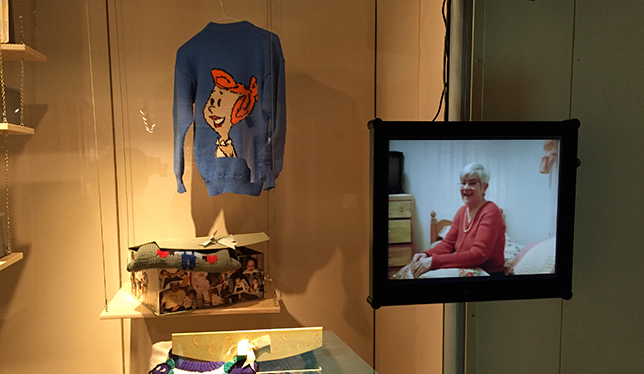A McMaster University professor has teamed up with the Ontario Science Centre to challenge the traditional concept of an archive in a unique gallery dedicated to emerging researchers and artists.
The Archive of Everyday Life exhibition at the OSC’s Idea Gallery is a collection of student work from a graduate-level cultural studies course that Mary O’Connor has taught at McMaster University since 2008. During the course, students read the work of theorists like Jacques Derrida, Giorgio Agamben and Michel de Certeau, and discuss the processes and products of archiving: whose stories get included; whose experiences are omitted; how the archive reflects the archivist’s priorities and values. As part of the coursework, Dr. O’Connor requires her students to create their own archive of everyday experience – of “things we don’t usually see,” she said. Students have returned with a heap of trash found during walks, a documentary of a daily drive around Hamilton, a collection of the mundane belongings of a deceased parent, among other projects.
Dr. O’Connor, recent McMaster PhD graduate Simon Orpana and PhD candidate Ben Prus curated the exhibit, paring it down to 17 archives from the 68 that had been created throughout the course. “I was looking for something that had visual appeal. It had to be able to attract the attention of Science Centre goers,” said Dr. O’Connor. Lisa Molnar’s “Saturated Threads: Nagymama’s Kötött Archiv,” an archive of her late grandmother’s knitting, was an obvious choice. A meditation on how a beloved relative’s handicraft influences family relationships and identity, the collection includes memory boxes covered in collages of family photos, footage of interviews Ms. Molnar conducted with her nagymama (“grandmother” in Hungarian), her father and her brother, and a few hand-knit sweaters. (The centrepiece is a bold purple sweater featuring Wilma Flintstone on one side and Betty Rubble on the other.)
Ms. Molnar, now an elementary school teacher, said she’s proud to be a part of a show that encourages young people to rethink what gets labelled as art. “It also has given me the impetus to create more, to be more active in my [artistic] community. It’s opened up my imagination and my mind to what I can do,” she said.
For Dr. O’Connor, that’s the point of showcasing student work. “It reinforces the value of the work they did in the course and the kind of really interesting thinking that went on in the making of these projects.” Both she and Ms. Molnar are particularly happy to have had the chance to work with the Idea Gallery, a space dedicated to blurring the boundaries between art and science, and to collaborative work between emerging artists and researchers.
The Idea Gallery sits at the lower level of the OSC’s Weston Family Innovation Centre. Both the gallery and the Weston wing opened in 2005 as a result of a major renovation and review of the Science Centre’s objectives. “The goal … was to re-examine and reimagine how our visitors interact with science and how science is relevant to them in their everyday lives,” said Sabrina Greupner, manager of the Innovation Centre.
“One thing I like about [The Archive of Everyday Life] is that it’s incredibly subtle. One of its key messages has to do with what archiving actually is and what it represents to a society,” Ms. Greupner said. “We’ve had cool conversations, especially with kids, about what they collect and what that says about them – what’s important to them,” she said.
In 2005, the gallery’s first show consisted of artwork created by OCAD University students out of Corian, a solid surface material generally used for kitchen counters. The show coincided with a featured OSC exhibit on materials science. Since then, most of the shows that have been mounted at the Idea Gallery have been in partnership with a postsecondary institution. Students from OCAD U, the University of Toronto and Toronto’s Sheridan College are regularly featured, though previous exhibits have included work from students and faculty at York University, University of Windsor, Ryerson University, McGill University and the University of British Columbia.
Ms. Greupner credits Idea Gallery curator Ana Klasnja with the success of these partnerships. “Through her connections with professors, instructors and youth organizations, she’s pretty much managed to schedule out the gallery two years in advance.”
That being said, the gallery has an ongoing open call for submissions. “We are interested in promoting a wide variety of individuals or groups,” Ms. Klasnja said. She invites anyone interested in submitting a proposal to contact her directly with a detailed pitch (including images) or to reach her through the Ontario Science Centre website.
The Archive of Everyday Life runs until May 24.
